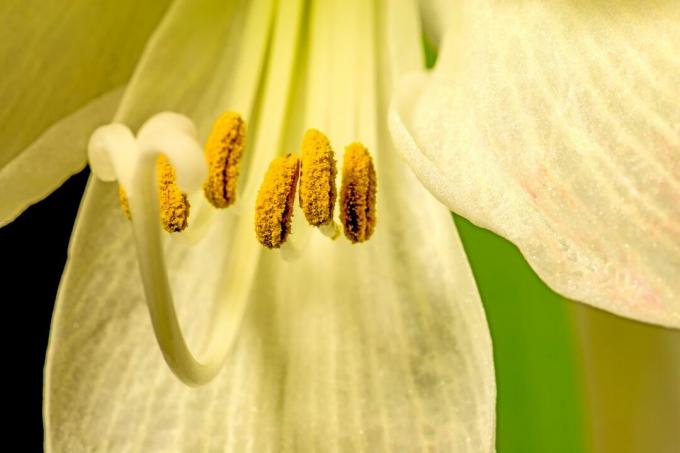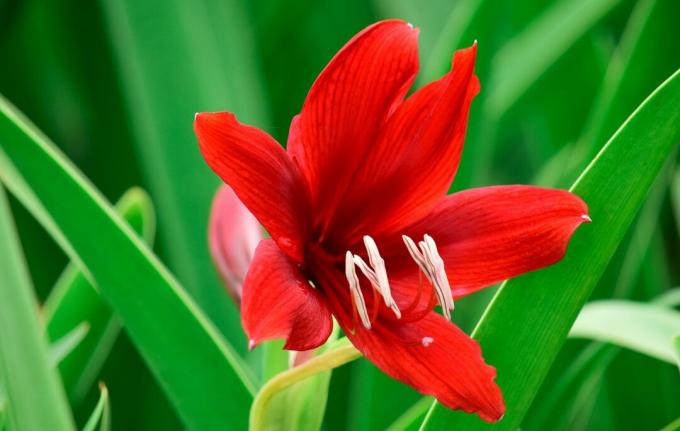In winter, the amaryllis delights with its magnificent and colorful flowers. More about propagation and growing from seeds can be found here.

From December to February delights the amaryllis (Hippeastrum) with imposing flowers in white, pink or red. To some is the amaryllis (Amaryllidaceae), which forms an onion, perhaps better known as a knight star. This German name also fits better than the name “Amaryllis”, which came from the past. The more than 70 species once belonged to the genus amaryllis, but meanwhile they became their own genus Hippeastrum assigned. However, the name Amaryllis has stuck for the winter bloomer even in the horticultural world. Once you have bought an amaryllis, with a little care and the right attention at the right time, the bulb can become a flowering companion for several years. You can also increase the number of amaryllis that bloom on your windowsill from December onwards by propagating them yourself. The amaryllis can not only be propagated by seeds. We take a closer look at the various propagation options for the amaryllis.
contents
- Grow amaryllis from seed
-
Propagating amaryllis vegetatively
- Propagating amaryllis with bulbs
- Propagate amaryllis by onion skin cuttings
Grow amaryllis from seed
Propagation via the seeds of the amaryllis is possible, but also very expensive for the hobby gardener. In addition, the characteristics of the offspring can be different from those of the mother plant due to the genetic segregation of certain traits. Pollination must be done by hand. The pollen-rich anthers are rubbed off at the stigma. You can pollinate the stigma of the same flower (self-pollination) or the stigma of another Amaryllis plant (cross-pollination).

The best pollination success is achieved by manual pollination if only the first two flowers of a flower are pollinated and all other flowers are removed. About eight weeks after pollination, the seeds are ripe and can be harvested. They should be sown immediately, as the ability to germinate decreases quickly. The first seedlings appear after about four weeks. The seedlings are pricked out and cultivated for 2.5 years until they can be prepared for flowering in the second autumn. More to Caring for amaryllis after flowering find out in our article. Here is the process if you want to grow amaryllis from seeds:
- Hand pollination required
- It is best to pollinate the first two flowers of an onion and remove the remaining flowers
- Self- or cross-pollination possible
- Seed can be harvested after about 8 weeks
- It is best to sow directly, as the germination rate decreases more quickly with increasing storage time
- Germination occurs after about 4 weeks
- Prick out seedlings, pot and cultivate for 2.5 years
- In the second autumn, prepare the seedlings for forcing and flowering
Propagating amaryllis vegetatively
Amaryllis can also be propagated vegetatively. This means that organs are taken from a plant and a new plant is grown from them. This is a clone of the mother plant, so the offspring are exactly the same Have characteristics like the mother - a clear advantage compared to generative propagation about seeds. In addition, the processes of vegetative propagation are sometimes significantly less complex and lead to flowering faster. We look at which possible vegetative forms of propagation are available in the case of amaryllis.

Propagating amaryllis with bulbs
If the amaryllis are repotted after a successful summer season in preparation for the flowering phase, it is possible that small bulbs will be discovered on the mother plant. These can be carefully removed from the main bulb and used to propagate the amaryllis. The small spring onions are initially stored at temperatures of around 15 °C. The onions are then planted from January. Just as with the seedlings, the onions used should only be prepared for forcing and flowering in the second autumn.

TIP: Increase the chance of developing bulbs by making multiple cuts in the bulbous base of the mother plant. Here is the procedure if you want to propagate amaryllis with bulbs:
- Increase the probability of formation of brood onions by making cuts in the base of the mother onion
- Remove the onions from the mother onion when repotting in November
- Store the onions at 15 °C and plant them from January
- In the second fall, make preparations for the flowering of amaryllis
Propagate amaryllis by onion skin cuttings
The amaryllis can also be propagated by so-called onion skin cuttings. For this purpose, the bulbs to be propagated are not driven and brought into bloom in winter, but are stored at relatively low temperatures. It is best to start propagating in January. The amaryllis bulb is cut slightly at the bottom to remove the roots. The onion is now halved vertically and further divided in the vertical direction.

Depending on the size of the amaryllis bulb, 12 to 16 individual pieces of the same size can be cut from one bulb without any problems. The onion wedges can each be divided vertically into two or three equal pieces. This gives you long, narrow onion pieces, each containing part of the onion base. These are then stuck in sand in the direction of growth. At temperatures above 20 °C, new roots form quickly and after three months small bulbs can be discovered from which leaves develop. After transplanting in summer/autumn, the newly harvested bulbs should be left for another year and only used for flowering in the second autumn. Here is the procedure if you want to propagate amaryllis with onion skin cuttings:
- Do not fork amaryllis bulbs, but continue to store them at rather lower temperatures until January
- Remove roots and lightly cut onion base
- Slice the onion vertically into 12 to 16 equal wedges
- Halve or third the onion wedges again, also in a vertical direction
- Stick the onion pieces in the sand in the direction in which they grow
- Optimum temperature 20 – 25 °C
- Root formation after a few weeks, bulb formation after three months
- Transplant and grub up in the second fall and use for flowering
There are several promising methods available to propagate the amaryllis yourself. Compared to other cultures, however, all are relatively expensive. But even the relatively long time and diligence that both have to be expended in order to produce a flower on self-propagated amaryllis will pay off in magnificent flowers in the end!
In order to be able to call the most magnificent amaryllis your own, you should Amaryllis care don't neglect. Here you can find out what needs to be taken into account.
